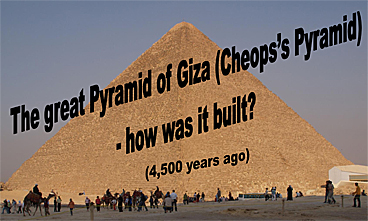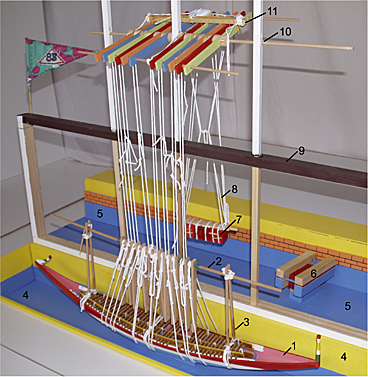PowerPoint presentation
by the book author
Helmar Neubacher!

RAMPS OR MACHINES?
The Great Pyramid of Giza is the biggest of all pyramids and counts to the Seven Wonders of the World. Many mysteries and theories, especially concerning the method of its construction, revolve around it. How was it possible for the ancient Egyptians some 4,500 years ago to create such an architectural feat?
– to transport, lift and put in place more than 6 million tons of stone?
Those interested will hear which role the water of the Nile and the power of levers could have played in ancient Egypt, and why it is adequate to closely examine the present theories on the building of the pyramid. For years already Helmar Neubacher, who had spent years at see, has dedicated his time to the history, land and legends on this topic and has already published three books on the subject. The presentation supplemented with descriptive model material.
An informative PowerPoint presentation including an own theory on the colossal building held by the Graduate Engineer for Marine Engineering Helmar Neubacher on

Thursday the 29th of
March 2018, 7:30 p.m.
Thursday the 17th of
May 2018, 7:30 p.m.
Conference room "Alte Post"
25980 Westerland
PowerPoint presentation does not take place!
MILLENIUM PUZZLE ENCOMPASSING
THE GREAT PYRAMID
PYRAMID CONSTRUCTION IN ANCIENT EGYPT
Sensationel findings by the engineer
Helmar Neubacher from Westerland Sylt
The on the left shown machine of Herodotus (according to the idea of the author H. Neubacher) raised a standard block, as it was installed in the Great Pyramid, on 12.02.09 in Thailand! Only the water tank (brown) and the floating Lifting-craft in the water tank had to be adjusted to the weight of the stone.
The student Jo-i here with her body height of 1,54 m is an opportunity to compare the height of the stone block used
(1 m), and which was remade in Thailand by the author.
LIFTING WITH HYDROPOWER
WITH THE HELP OF LIFTING-SHIPS
Was this the technology, which had been used for the emergence of Stonehenge at the same time, but later had been lost?
The brant new book:
"VERMÄCHTNIS des HERODOT
zum Bau der
CHEOPS-PYRAMIDE
Jahrtausende altes Mysterium gelüftet:
100.000 Mann - Hydrostatik - 230 Steinhebemaschinen"
Compared to the above described standard blocks (2.5 tons) and the megaliths of Stonehenge, still bigger weights of stone were to be built into the Cheops Pyramid. Illustration 3 shows H. Neubacher and how he imagines the solution of transport of about 100 megaliths weighing up to 60 tons, towards the tip of the pyramid.

Image 3: Bark of Khufu floating in the 53-meter- long ship´s pit No.3, on the Giza sight lifting a granite megalith of 53 tons.
Scale of model: 1 : 58. Supporting wall for lifting beam and canal are open to the front to demonstrate the overall function of the stone lifting unit.
- Bark of Cheops
- Lifting beam of the bark
- Support for lifting beam
- Ship´s pit No. 3 with water
- Canal
- Transport vessel with monolith, floating beneath the surface of the water.
- Monolith being lifted
- Haulage rope
- Support wall for lifting beam
- Pivot of lifting beam
- Twelve lifting beams (c.f. Image 6)
In the new book, on page 65, you can see the above illustration supplemented by three transport dams of 20 metres height, water inlet valve to the ships´ pit and pyramid workers to bail out water, who are standing at the edge of the pit to lower the "lifting vessel" (bark) for the lifting of the monolith (No.7).
gebaut mit den eigenen
Barken
published in September 2008
ISBN: 978-3-8370-6236-6
Language: German
Here you can order the first book online:
published in April 2009
ISBN: 978-3-8370-2310-7
Language: German
Here you can order the second book online:
zum Bau der Cheops-
Pyramide
published in December 2010
ISBN: 978-3-8391-1486-5
Language: German
Here you can order the third book online:
From each copy sold, 25 %
of the author's royalties are
donated towards children in
danger of starvation.
Other interesting books by shadoof-book and advertising opportunities for your books at www.schaduf-book.de


